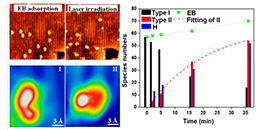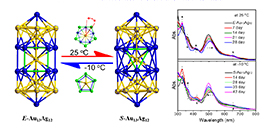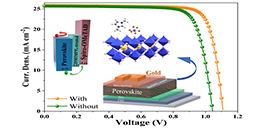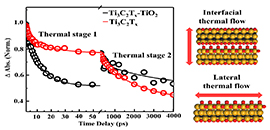Research News
-
 12 18, 2020Researchers Discover C-H Bond Activation Reactions at Low Temperature by Photo-induced MeansScientists discovered the C-H bond breaking reaction catalyzed by low-temperature photocatalysis on the surface of titanium oxide, and explained the reaction mechanism at the single molecular level.
12 18, 2020Researchers Discover C-H Bond Activation Reactions at Low Temperature by Photo-induced MeansScientists discovered the C-H bond breaking reaction catalyzed by low-temperature photocatalysis on the surface of titanium oxide, and explained the reaction mechanism at the single molecular level.
C-H bond is very important in organic chemistry. Chemical reactions related to the break and further synthesis of C-H bond require high activation energy and poor selectivity. Therefore, it's important to understand reaction mechanism of C-H bond.
Recently, a research team led by Prof. YANG Xueming and Prof. MA Zhibo from the Dalian Institute of Chemical Physics (DICP) of the Chinese Academy of Sciences (CAS), in collaboration with Prof. PAN Minghu from the Huazhong University of Science and Technology, discovered the C-H bond breaking reaction catalyzed by low-temperature photocatalysis on the surface of titanium oxide, and explained the reaction mechanism at the single molecular level.
The results were published in The Journal of Physical Chemistry Letters on November 10.
High-resolution STM visualizing the intermediate states of the reaction and the reaction pathway of EB dehydrogenation on TiO2 (Image by WANG Haochen)
The scientists used the rutile 110 surface of titanium oxide as the model system and the C-H bond molecule ethylbenzene as the model molecule.
They found that ethylbenzene could be induced to remove hydrogen at low temperature (77K) only by photoinduced reaction. They also experimentally observed the images of the reaction steps by in-situ tracking single molecules.
Prof. PAN's team provided theoretical support for the theoretical interpretation of the image and confirmed the reaction process.
This work was supported by the Chinese Academy of Sciences Strategic Pioneer Science and Technology Special Project (Category B), the Chinese Academy of Sciences' Key Frontier Science Research Program, the National Key Research and Development Program of the Ministry of Science and Technology, and the National Natural Science Foundation of China. (Text by WANG Haochen) -
 12 18, 2020Scientists Synthesize Atomically Precise AuAg Nanoclusters for Rotary NanomotorsScientistsdiscovered the reversible conversion in metal nanoclusters driven by temperature for the first time, exploiting the application of metal clusters in the field of nanomotor.
12 18, 2020Scientists Synthesize Atomically Precise AuAg Nanoclusters for Rotary NanomotorsScientistsdiscovered the reversible conversion in metal nanoclusters driven by temperature for the first time, exploiting the application of metal clusters in the field of nanomotor.
Metal nanoclusters, emerging as an atomically precise nanomaterial, exhibit unique physicochemical properties.
With the rapid advance in synthesis and characterization of clusters, more and more attention has been drawn to the application of metal clusters in various fields, such as photoluminescence, catalysis, medicine, biosensor, molecule machine.
Recently, a group led by Prof. LI GAO from the Dalian Institute of Chemical Physics (DICP) of the Chinese Academy of Sciences (CAS), in collaboration with Prof. WAN Chongqing from Capital Normal University and Prof. JIN Rongchao from Carnegie Mellon University, discovered the reversible conversion in metal nanoclusters driven by temperature for the first time, exploiting the application of metal clusters in the field of nanomotor.
This work was published in Nature Communication on November 26.
Nanocluster-based rotary nanomotor (Image by QIN Zhaoxian)
In this study, the scientists proposed a strategy to synthesize Au13Ag12 nanocluster.
They discovered a reversible conversion between isomers in Au13Ag12 nanoclusters composed of two icosahedrons by sharing an Au vertex. And the result was confirmed by mass spectroscopy (ESI-MS), ultra-visible absorption spectroscopy (UV-vis), and differential scanning calorimeter (DSC) analysis.
The discovery of reversible conversion in nanoclusters tailored by temperature may enrich the application of different-sized clusters.
This work was supported by Liaoning Natural Science Foundation of China and Liaoning Revitalization Talents Program. (Text by QIN Zhaoxian) -
 12 17, 2020Scientists Increase Efficiency of Perovskite Solar Cells with Imidazolium-based Ionic LiquidScientists from DICP reported high-efficiency perovskite solar cells with imidazolium-based ionic liquid for surface passivation and charge transport.
12 17, 2020Scientists Increase Efficiency of Perovskite Solar Cells with Imidazolium-based Ionic LiquidScientists from DICP reported high-efficiency perovskite solar cells with imidazolium-based ionic liquid for surface passivation and charge transport.
The quality of perovskite film plays a key role in device performance. In general, the perovskite film is prepared by evaporating solvent from the precursor solution.
However, it yields defects at the grain boundaries and on the surface during the crystallization process. These defects cause perovskite decomposition and non-radiative recombination, causing negative impact on the device performance.
Surface passivation is considered as one of the most effective ways to reduce the number of defects due to its ease of application.
Recently, a research group led by Prof. LIU Shengzhong from the Dalian Institute of Chemical Physics (DICP) of the Chinese Academy of Sciences (CAS) reported high-efficiency perovskite solar cells with imidazolium-based ionic liquid for surface passivation and charge transport.
This results were published in Angewandte international Edition Chemie on November 6.
Efficient perovskite solar cells with imidazolium‐based ionic liquid for surface passivation and charge transport fabricated (Image by DUAN Lianjie)
"We used a novel 1,3-dimethyl-3-imidazolium hexafluorophosphate (DMIMPF6) ionic liquid (IL) to treat the perovskite surface and achieved a high power conversion efficiency of 23.25%," said Prof. LIU.
DMIMPF6 modulated the interfacial electronic properties of the perovskite, leading to a better-matched interfacial energy-level alignment between the perovskite and hole transport layer. DMIMPF6 IL had a strong passivation effect on the perovskite surface due to the formation of an electrostatic interaction between Pb2+ ions and DMIMPF6.
Moreover, since thin hydrophobic DMIMPF6 passivation layer blocked water permeation, DMIMPF6-treated devices showed remarkable long-term environmental stability.
This work offers an efficient way to reach future commercial production of high-performance perovskite photovoltaics.
This work was supported by National Natural Science Foundation of China, the Shaanxi Technical Innovation Guidance Project, S.L. acknowledges the Strategic Priority Research Program of Chinese Academy of Sciences, the National Key Research and Development Program of China, the National University Research Fund, the Innovative Research Team, the 111 Project. (Image by DUAN LianJie) -
 12 17, 2020Ultrafast Time-resolved Spectroscopy Reveals Heat Transfer Mechanism for MXene Oxidation StructureScientists revealed that surface oxidation could modulate the interfacial and lateral thermal migration of MXene (Ti3C2Tx) Flakes.
12 17, 2020Ultrafast Time-resolved Spectroscopy Reveals Heat Transfer Mechanism for MXene Oxidation StructureScientists revealed that surface oxidation could modulate the interfacial and lateral thermal migration of MXene (Ti3C2Tx) Flakes.
The emerging two-dimensional transition metal oxide (MXene) is promising in multi-functional fields, including energy storage, electromagnetic shielding, and photodetection.
During the application process, the movement of electrons on the electrode causes heat generation and local temperature rise in the Ti3C2Tx sheet, which brings the risk of limited oxidation. Therefore, it is necessary to understand the microscopic mechanism of thermal energy transfer in order to avoid or mitigate thermal damage for Ti3C2Tx flake.
Recently, a group led by Prof. YANG Xueming and Prof. YUAN Kaijun from the Dalian Institute of Chemical Physics (DICP) of the Chinese Academy of Sciences, in cooperation with Prof. LI jiebo and Prof. YAN Xin from Beihang University, revealed that surface oxidation could modulate the interfacial and lateral thermal migration of MXene (Ti3C2Tx) Flakes.
The results were published in Journal of Physical Chemistry Letters on October 28.
Surface oxidation modulated the interfacial and lateral thermal migration of MXene (Ti3C2Tx) flakes (Image by ZHANG Qi)
Using femtosecond ultrafast time-resolved spectroscopy and molecular dynamics simulations, this team revealed the Ti3C2Tx-TiO2 interface structure in partial oxidation of Ti3C2Tx could accelerate the heat transfer rate between the interfaces but hinder the in-plane thermal diffusion rate.
The molecular dynamics simulation clarified the relationship between the oxidation probability of Ti3C2Tx interface and the thermal conductivity. It also explained the influence of the chemical bond structure on the thermal conductivity from the molecular level.
This work was supported by the National Natural Science Foundation of China, the Strategic Priority Research Program of the Chinese Academy of Sciences, the Chemical Dynamics Research Center, and the international partnership program of Chinese Academy of Sciences. (Text by Zhang Qi) -
 11 03, 2020Scientists Construct M29 Cluster Model CatalystScientists synthesized a novel atomically precise AuAg cluster with special structure, which is exploited as a model catalyst for A3-coupling reactions.
11 03, 2020Scientists Construct M29 Cluster Model CatalystScientists synthesized a novel atomically precise AuAg cluster with special structure, which is exploited as a model catalyst for A3-coupling reactions.
Recently, a group led by Prof. LI GAO from the Dalian Institute of Chemical Physics (DICP) of the Chinese Academy of Sciences, in collaboration with Prof. WAN Chongqing from Capital Normal University and Prof. Hannu Hakkinen from University of Jyvaskyla, synthesized a novel atomically precise AuAg cluster with special structure, which is exploited as a model catalyst for A3-coupling reactions.
This work was published in Angew. Chem. Int. Ed. on September 30.
Total structure and negative-mode ESI mass spectrum of the Au13Ag16L24 cluster, the Au@Ag12@Au12Ag4 metal framework protected by alkyne groups from 24 ligands (Image by QIN Zhaoxian)
The scientists prepared a brand new alkynylated cluster [Au13Ag16(C10H6NO)24]3- by NaBH4 mediated reduction method. And confirmed the AuAg clusters by various sophisticated characterization techniques. They found that the unique metal framework of "Aucenter@Ag12@Au12Ag4" was protected by 24 atypical alkyne ligands L (L = C10H6NO).
The ligands were found to construct a unique type of motif L-(Ag)-Au-(Ag)-L at the cluster interface, where, the alkyne (C≡C) group of each L was linked by sharing an Au atom through the σ bonds and each C≡C group was discretely connected to chemically different Ag atom through π bonds.
DFT characterized the cluster as a clear 8-electron superatom, and peaks in the optical absorption spectrum were interpreted in terms of the P and D superatom states. The supported Au13Ag16L24/CeO2 catalyst exhibited high catalytic activity and selectivity towards the A3-coupling reaction involving benzaldehyde, diethylamine and phenylacetylene.
This work was supported by Liaoning Natural Science Foundation of China, and Liaoning Revitalization Talents Program. (Text by QIN Zhaoxian) -
 11 02, 2020"Liquid Sunshine" Enlightens New Way of Green EnergyThe world's first project of "Liquid Solar Fuel Production demonstration Project" passed the scientific and technological achievement evaluation certified by China Petroleum and Chemical Industry Federation on October 15.
11 02, 2020"Liquid Sunshine" Enlightens New Way of Green EnergyThe world's first project of "Liquid Solar Fuel Production demonstration Project" passed the scientific and technological achievement evaluation certified by China Petroleum and Chemical Industry Federation on October 15.
The potential of renewable energy in China is huge. Replacing fossil fuels with renewable energy and lowering carbon emissions have become important issues for sustainable development.
Recently, a research team led by Prof. LI Can from the Dalian Institute of Chemical Physics (DICP) of the Chinese Academy of Sciences and their collaborators industrialized the liquid solar fuel production through the "Liquid Solar Fuel Production demonstration Project".
They used commercial photovoltaic technology to generate electric power, the independently developed alkaline water electrolysis catalysts to produce renewable hydrogen, and carbon dioxide hydrogenation catalyst to produce methanol in the end. Therefore, the liquid solar fuel production was called "liquid sunshine".
"It is a new way for the large scale production of green liquid fuels with renewable energy," said Prof. LI.
The plant of "Liquid Solar Fuel Production demonstration Project" (Image by DICP)
One of the key innovative technologies of the project is the efficient, low-cost and long-lifetime electrocatalyst for alkaline water electrolysis in hydrogen production, which had been approved to be best electrocatalyst reported so far for large-scale alkaline water. The facility had a capacity for production of more than 1,000 standard cubic meters of hydrogen per hour on a single set of industrial electrolytic cells, and the unit hydrogen energy consumption was reduced to less than 4.3 kilowatt hours per cubic meter.
The other is the low-cost, high-selectivity and high-stability carbon dioxide hydrogenation catalyst for methanol production. The zinc oxide/zirconium oxide bimetallic oxide solid solution catalyst had achieved 1,000 tons/year green methanol synthesis. The selectivity of methanol reached 98%, and the content of methanol in reached 99.5%. What's more, the catalyst was resistant to poisoning and sintering.
The plant of the "Liquid Solar Fuel Production demonstration Project" consisted of three basic units: solar photovoltaic for renewable electricity generation, alkaline water electrolyzer for green hydrogen production, and methanol synthesis by carbon dioxide hydrogenation.
The photovoltaic power station with a total power of 10 MW provided electricity for alkaline water electrolyzer to hydrogen production, which was used in the end station for carbon dioxide hydrogenation to produce methanol. (Text by HAN Hongxian)